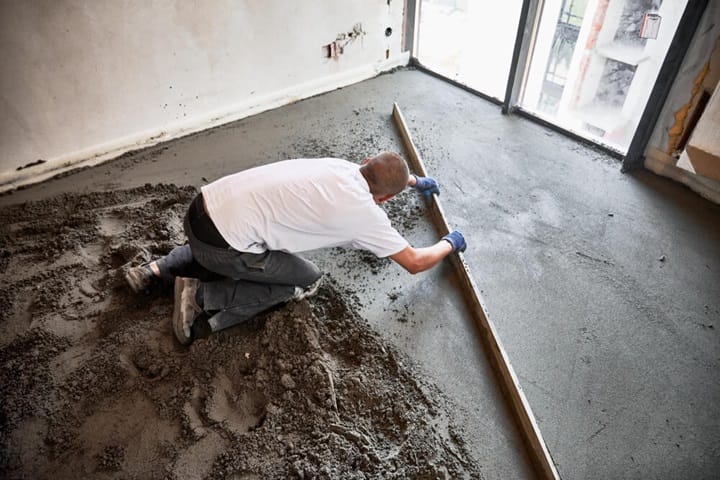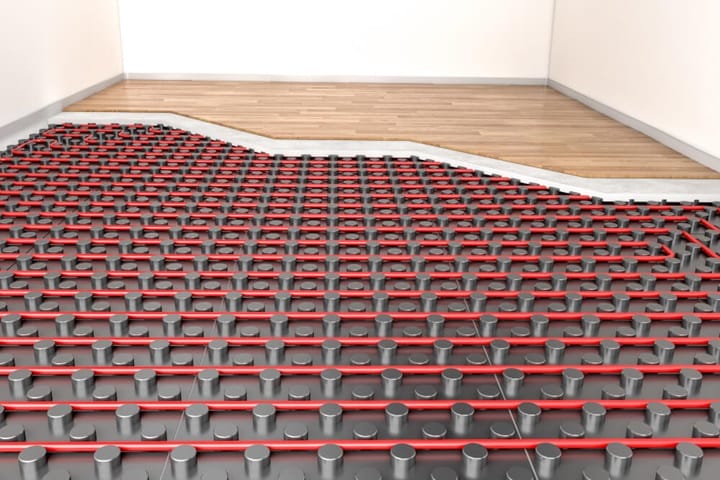Turning on underfloor heating for the first time? Don’t rush it. The wrong approach can lead to long-term damage—especially if you’ve just laid new flooring.
Whether your underfloor heating system is brand new or has been off since last winter, this article will walk you through how to turn it on safely. From checking if your screed is dry to knowing the right temperature for your flooring type, we’ll cover everything you need to know. You’ll also learn what to do if your system’s been off for a considerable amount of time, and how long does underfloor heating take to warm up.
Key Points:
- Let screed dry fully before switching on your system
- Different floors (timber, carpet, vinyl) need different warm-up approaches
- Don’t overheat your system to speed things up—take it slow
- Systems left off for months should be restarted gradually
- Smart thermostats can make managing your UFH easier
- If Your Underfloor Heating System Has Just Been Laid
- Is the Screed Fully Dry?
- What Flooring Are You Using?
- Timber Flooring
- Stone and Ceramic Tiles
- Vinyl and Linoleum Flooring
- Carpet
- If Your System Has Been Off for a While
- How Long Does Underfloor Heating Take to Warm Up?
- Using Smart Thermostats
- How To Test Your Underfloor Heating Before Full Use
- What To Do If Underfloor Heating Isn’t Working After Switch-On
- Choose The Right Time To Turn On Underfloor Heating
- FAQs
- Sources
If Your Underfloor Heating System Has Just Been Laid
It’s tempting to turn the heating on as soon as the installation is finished—but hold fire. Turning on underfloor heating for the first time requires a few checks to avoid problems down the line.
Is the Screed Fully Dry?

How long does screed take to dry, you may ask. If your underfloor heating system is embedded in screed, the most important step before switching it on is making sure the screed is completely dry. Turning the system on too early can trap moisture, causing the screed to crack or weaken. This can affect how evenly your floor heats up—or worse, damage your floor finish altogether.
Drying times vary depending on the type of screed used:
- Traditional sand and cement screed: Usually takes 1 day per mm for the first 50mm
- Anhydrite or liquid screed: May take longer, often 1mm per day in ideal conditions
Do not use the underfloor heating system to speed up the drying process—it can do more harm than good. Always check with your installer or screed supplier if you’re unsure.
What Flooring Are You Using?

Your flooring also plays a part in how you go about turning on underfloor heating for the first time. For example, underfloor heating on floorboards or timber floors can be particularly sensitive to sudden changes in temperature and may warp if heated too quickly. What temperature should underfloor heating be? Find out now.
Take the time to check the manufacturer’s recommendations for your flooring. Most will advise gradual heat increases over several days, especially for natural materials.
Let’s break it down by flooring type.
Timber Flooring
Wood reacts to sudden changes in heat, so a slow and steady approach is best. Start by setting the heating mixing valve (or heat pump flow temperature) to around 40°C. Then, increase the temperature by no more than 5°C per day until you reach your system’s design temperature.
For homes using timber flooring, this staged warm-up will help the wood adjust gradually, reducing the risk of shrinkage or buckling.
Stone and Ceramic Tiles
Stone and ceramic are more heat-resistant and less prone to movement. That said, they still benefit from a careful warm-up. If you’re fitting these materials over a water underfloor heating system, it’s best to include a decoupling membrane. This protects against slight movements in the subfloor and ensures even heat distribution. What is a subfloor?
Before turning on underfloor heating for the first time with these materials, double-check the tile manufacturer’s max temperature recommendations. The best tiles for underfloor heating, such as ceramic and stone tiles, are safe up to around 29–30°C.
Vinyl and Linoleum Flooring
Vinyl and lino floors need extra care when paired with UFH. The flooring should be laid flat for at least 24 hours before installation. During that time, the room should be kept at a stable temperature between 18–26°C—but do not use underfloor heating to achieve this.
Once installed:
- Turn off the underfloor heating 48 hours before fitting
- Keep it off during installation
- Wait another 48 hours after installation before switching it back on
Once you’re ready, increase the temperature slowly and ensure that any adhesive used can handle UFH temperatures—typically up to 27°C.
Carpet
Carpeted floors can work well with UFH systems, but only if installed carefully. Like vinyl, carpet needs the heating system to be turned off 48 hours before laying, and kept off for another 48 hours after.
When turning on underfloor heating for the first time under carpet, increase the temperature gradually over a seven-day period. Also, make sure any adhesives used for underlay or grippers are rated for underfloor heating temperatures. Discover more about carpet underfloor heating.
If Your System Has Been Off for a While
Even if your system isn’t brand new, it still helps to treat it gently after a long break—such as following a warm summer and preparing it for winter. Heating it up gradually allows the floor and heating elements to adjust, reducing the risk of damage or unexpected problems with underfloor heating, including can underfloor heating crack tiles?
How Long Does Underfloor Heating Take to Warm Up?
Water underfloor heating kits use warm water from your boiler. These tend to warm up slowly because the heat needs to travel through pipes and across the subfloor.
Electric underfloor heating systems (wire or mat) heat up faster as they work by direct electrical current. Still, it’s best to give any system time to reach temperature before making adjustments.
Flooring also plays a role:
- Stone, tile, and vinyl warm up quickly
- Wood and carpet take longer due to their insulating properties
Don’t be tempted to turn the temperature up quickly if it feels slow—it may take a few hours, but the system will get there.
Using Smart Thermostats
Smart thermostats for underfloor heating are a simple way to manage temperature without constantly adjusting settings. Many systems—like those available from Underfloor Heating Trade Supplies—can be programmed to suit your routine.
Smart controls allow you to:
- Set heating schedules based on time of day
- Pre-warm rooms before you wake up or get home
- Monitor and control heat remotely from your phone
- Maintain a consistent and comfortable temperature
If you’re serious about getting the most from your UFH setup, consider a thermostat with floor sensors for even more precise control.
Check the latest Approved Document L guidance from GOV.UK for official advice on fuel conservation, heating controls, and system efficiency in homes.
How To Test Your Underfloor Heating Before Full Use
Testing underfloor heating is a step many people skip, but it can help catch problems early—especially if you’re installing a brand new system. Whether it’s a wet or electric setup, testing before laying flooring or fully switching on is a good idea.
If you’re using electric underfloor heating mats or wires, check the resistance using a multimeter before and after installation. This will confirm whether the elements are intact and haven’t been damaged during fitting. Most manufacturers list the expected resistance range in the product manual—compare your reading to be sure everything is working as it should.
For wet systems, an underfloor heating pressure test is recommended before screeding. This involves filling the pipes with water and monitoring the pressure for a set period (often 24 hours) to check for leaks. If the pressure drops significantly, it could point to a joint or fitting issue.
Once your system is connected, you can also run a low-temperature test cycle before laying down any flooring. This checks that the heat is being distributed evenly across each zone, which helps avoid surprises later on.
Always keep a record of your test results—some manufacturers require this for warranty validation. Testing takes a bit of extra time, but it’s worth it for peace of mind before turning on underfloor heating for the first time.
What To Do If Underfloor Heating Isn’t Working After Switch-On
If your system isn’t heating up after being turned on, don’t panic—it doesn’t always mean there’s a serious problem. Whether you’re turning on underfloor heating for the first time or restarting it after a long break, a few common checks can help you get things working properly.
Start with the basics: is your thermostat switched on and set to the correct mode? Some systems need a manual boost or time to sync after setup. Check the room temperature setting and make sure it’s set higher than the current room temperature to trigger heating.
For wet underfloor heating, confirm that your boiler is running and that the underfloor heating manifold and motorised valves are open. Trapped air in the pipes can cause cold spots—bleeding the system or checking for airlocks may solve the issue.
Electric underfloor heating systems should be checked for continuity using a multimeter. If there’s no power, inspect the underfloor heating wiring and thermostat connections. Sometimes, a tripped circuit or loose wiring could be the cause.
If all else fails and the system still isn’t responding, it’s worth getting in touch with your installer or a qualified heating engineer. Faulty connections, sensors, or blending valves might need professional attention—especially if you’re still within your warranty period. Need help with a product purchased from us? Contact our team today so that we can assist with your enquiries.
Choose The Right Time To Turn On Underfloor Heating
In conclusion, turning on underfloor heating for the first time isn’t just about flicking a switch—it takes care and patience. Whether your system is newly installed or has been off for a while, gradual warm-up is key. To summarise, make sure the screed is dry, follow flooring-specific advice, and avoid rushing the process. With smart controls and the right setup, your underfloor heating will deliver steady, reliable warmth for years to come—without damaging your flooring or wasting energy.
FAQs
Do I need to switch off underfloor heating when installing flooring?
Yes. For many floor types, underfloor heating should be switched off 48 hours before installation and kept off for at least 48 hours afterward. Always check both flooring and adhesive manufacturer guidelines.
Sources
GOV.UK. (2023) Conservation of fuel and power: Approved Document L. [online] Available at: https://www.gov.uk/government/publications/conservation-of-fuel-and-power-approved-document-l [accessed 10/07/2025]
